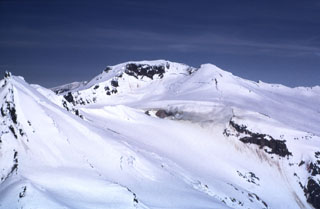Report on Kupreanof (United States) — March 1987
Scientific Event Alert Network Bulletin, vol. 12, no. 3 (March 1987)
Managing Editor: Lindsay McClelland.
Kupreanof (United States) Steam and ash emission from solfatara field
Please cite this report as:
Global Volcanism Program, 1987. Report on Kupreanof (United States) (McClelland, L., ed.). Scientific Event Alert Network Bulletin, 12:3. Smithsonian Institution. https://doi.org/10.5479/si.GVP.SEAN198703-312060
Kupreanof
United States
56.011°N, 159.797°W; summit elev. 1895 m
All times are local (unless otherwise noted)
On 10 March at about 1200 MarkAir pilot Jerry Chisum observed ash and steam emission from a solfatara field on the SSW flank (at 56.00°N, 159.81°W). The steam dissipated within 2 km of the solfatara field, but a grayish-brown ash horizon extended about 15 km N at 1,800 m altitude. On 17, 22, and 26 March Chisum made close observations of the region and noted only normal steam emissions. No previous eruptions are known in historical time.
Geological Summary. Kupreanof is the largest and NE-most of a group of five relatively closely spaced Quaternary volcanic centers opposite Stepovak Bay. A debris flow or block-and-ash flow with possible juvenile fragments descended a late-Pleistocene valley south of the volcano. This stratovolcano displays vigorous fumarolic activity, and although a "grayish-brown ash horizon" extending 15 km was reported by a pilot in 1987 after emissions from a SSW-flank solfatara field, the cause of this event is uncertain.
Information Contacts: J. Reeder, ADGGS.

